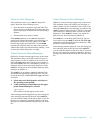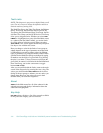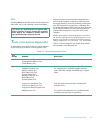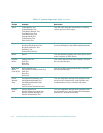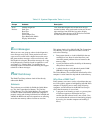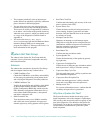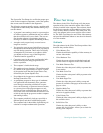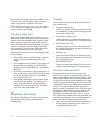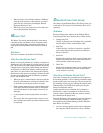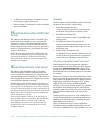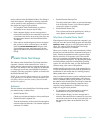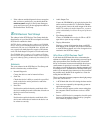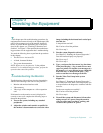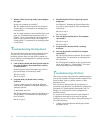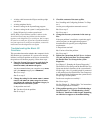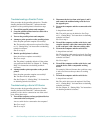
Running the System Diagnostics 5-15
•
When you press a key and the response is different
from the usual response or the response you antici-
pated, the key contact may be damaged. Run the
Keyboard Interactive Test.
•
When a key does not work at all, run all of the sub-
tests in the Keyboard Test Group.
M
ouse Test
The Mouse Test checks the functionality of the mouse
controller (which coordinates cursor movement on the
screen with corresponding movement of the mouse or
touch pad) and the operation of the mouse keys/touch
pad.
Subtests
There are no subtests for the Mouse Test Group.
Why Run the Mouse Test?
Mouse or touch pad problems are as likely to originate in
RAM as they are to be caused by a faulty mouse or touch
pad. Three sources of RAM-related problems include the
configuration of a program (which changes the function
of the mouse or touch pad), memory-resident programs,
and failure of a device driver (the software that controls
the function of the mouse or touch pad). If these possibil-
ities have been eliminated and the following symptoms
persist, run the Mouse Test:
•
When you press a mouse button or the touch pad, the
function of the button (or touch pad) continues; that
is, the button (or touch pad) seems to be stuck.
•
If the response when you press a mouse button or the
touch pad is different from the usual or anticipated
response, the button (or touch pad) contact may be
damaged.
•
A mouse button or the touch pad does not work at
all.
•
The cursor does not respond on the screen in accor-
dance with the movements you make with the mouse
or touch pad.
D
iskette Drives Test Group
The subtests in the Diskette Drives Test Group allow you
to test both 5.25-inch and 3.5-inch diskette drives of all
capacities.
Subtests
The four diskette drive subtests in the Diskette Drives
Test Group and the drive functions they confirm follow:
•
Change Line Test
Checks for bent pins on the diskette drive controller
and for defective lines on the diskette cable
•
Seek Test
Checks the drive’s ability to search for a specified
track on the diskette and to position its read/write
heads to all tracks
•
Read Test
Positions the read/write heads at each cylinder of the
diskette for reading data and verifies that all tracks
on the diskette can be read correctly
•
Write Test
Positions the read/write heads at each cylinder of the
diskette and verifies that all tracks on the diskette
can be written to correctly
Why Run a Diskette Drives Test?
Very often, a diskette drive problem may first appear to
be a diskette problem. A box of defective diskettes might
produce faulty-drive error messages. The test results can
be confusing, so Dell suggests running the subtests in the
Diskette Drives Test Group more than once using dis-
kettes from different sources.
Another possible cause of diskette drive problems is
human error—typing a command in an incorrect form
(usually called a syntax error). Be sure you have entered
the command in the proper form.
When the diskette(s) and command syntax are eliminated
as causes, the following symptoms usually suggest a
drive problem and warrant running a subtest in the Dis-
kette Drives Test Group:
•
An error message appears on the screen stating that
the computer cannot read from or write to a diskette.



